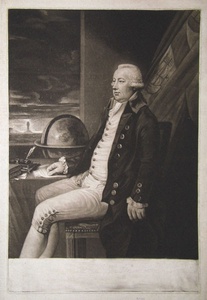| Method | Mezzotint |
| Artist | William Dickinson after Gainsborough Dupont |
| Published | [William Dickinson, c.1797] |
| Dimensions | Image 423 x 351 mm, Plate 480 x 355 mm, Sheet 533 x 387 mm |
| Notes |
Unfinished proof before all letters. The inscription space uncleaned. A portrait of the M.P. Robert Preston (1740-1834), looking to the left, with his right hand resting on a table with an inkwell, papers and a globe. Through the window a lighthouse and a turbulent sea are visible. According to the British Museum, the lighthouse may be a reference to Preston's involvement with the Corporation of Trinity House, an institution that provided navigational aids to the Royal Navy and the East India Company. Robert or 'Floating Bob' Preston (1740-1834) was the son of Sir George Preston, 4th Bt., of Valleyfield. In 1781, he was Elder Brother of the Trinity House. He was also M.P. for Dover (1784-90), and Cirencester (1792-1806). He is best known for rescuing his family's finances by making a fortune in the naval service of the East India Company. In later life he was a successful London insurance broker and ship owner. He worked at Frederick's Place, Old Jewry, and Old South Sea House, London. Lord Stowell described Preston to Lord Sidmouth in 1821, as 'a plain, unaffected man, very friendly,' who 'lives in a style of great hospitality'. His house in Downing Street was sold during his lifetime to government, and used to accommodate the Colonial Office. He died in 1834 at Valleyfield, Perth, Scotland. He reputedly left around one million pounds. William Dickinson (1746-1823) was a British mezzotinter and print publisher. He began his career with Carington Bowles. In 1767 he was awarded premium of the Society of Arts, and in 1773 he set up as his own publisher. Between 1779 and 1781 he worked in partnership with Thomas Watson; before declaring himself bankrupt in 1797. He then emigrated to Paris where he produced portraits for members of the Revolutionary and Napoleonic regimes. In 1814 Thomas Lawrence and Benjamin West visited him in Paris. West attempted to persuade him to return to London to engrave his paintings. He died in Paris in 1823. Gainsborough Dupont (1754-1797) was British painter and mezzotint engraver. Born in London, he was the eldest son of Thomas Gainsborough's sister, Sarah, and Philip Dupont. He was apprenticed to his uncle between 1772 and 1779. He entered the Royal Academy Schools in 1775, but continued to work in Gainsborough's studio, producing studio replicas, mezzotints and oil copies. After Gainsborough's death in 1788, Dupont inherited studio properties, and lived with his widowed aunt for a short period. He was patronised by William Pitt the Younger, and the royal family. He exhibited at the Royal Academy between 1790 and 1795. In 1793 he executed a series of theatrical portraits, and failed to be elected as an Associate Member of the Royal Academy. Chaloner Smith 63, O'Donoghue 512/1, Russell 63.i/ii, Lennox-Boyd state i/iii Ex. Col.: Hon. Christopher Lennox-Boyd Condition: Surface dirt to margins, otherwise excellent. |
| Framing | unmounted |
| Price | £450.00 |
| Stock ID | 33803 |

